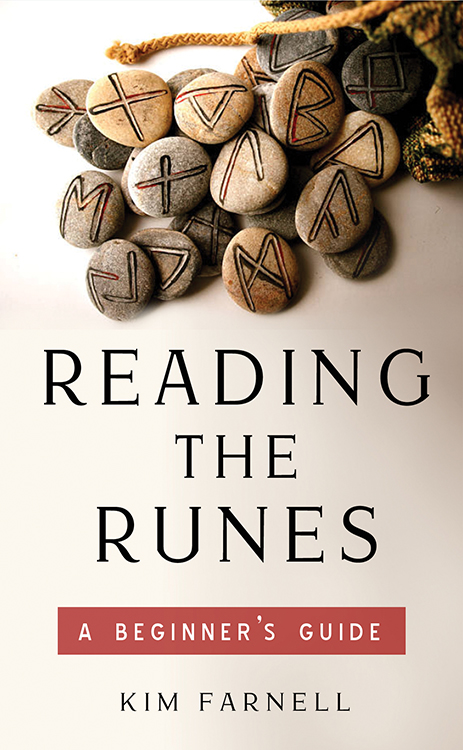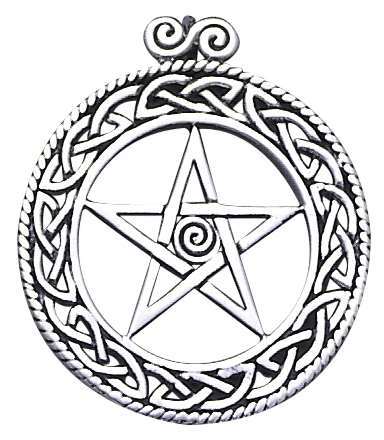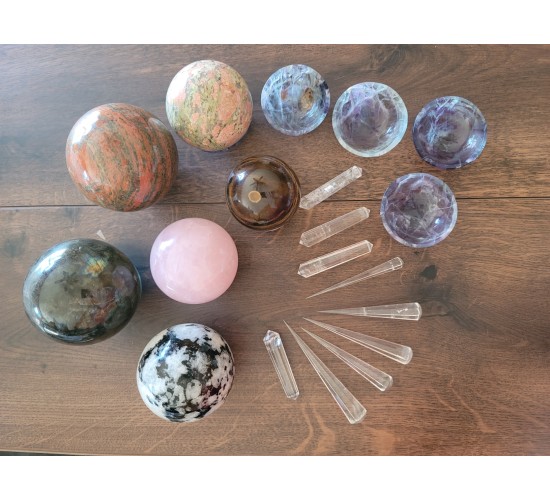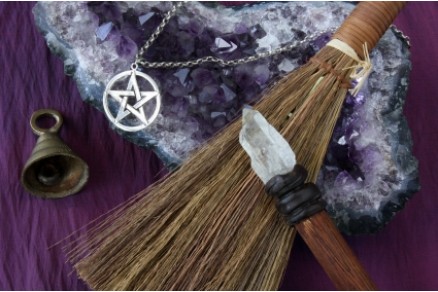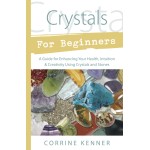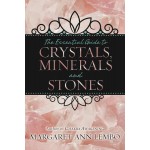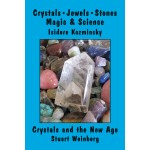How to Clean Your Crystals the Safe Way
- 3255
- 0
If you love your crystals like I do, you probably know they need a little extra care to stay as radiant as the day you got them. Crystals can become dust magnets, especially if you have them out on display, so it’s essential to know how to clean them safely without causing any damage. While some stones can be dunked in water, others are more delicate and need gentler care. The key to keeping them clean? Knowing their hardness and what they can handle.
Understanding Crystal Hardness: The Mohs Scale
When it comes to cleaning your crystals, one of the most important factors to consider is their hardness. This is where the Mohs Scale of Hardness comes in. Developed in 1812 by German mineralogist Friedrich Mohs, this scale ranks minerals based on their ability to resist scratching. It’s an essential tool for crystal enthusiasts because it helps you figure out which stones can withstand more robust cleaning methods, like water immersion or gentle scrubbing, and which ones need a more delicate touch.
The Mohs scale assigns each mineral a number from 1 (the softest) to 10 (the hardest). For example, talc sits at a 1, meaning it can be easily scratched by just about anything, while diamonds rank a perfect 10 and can only be scratched by other diamonds. This is key because minerals with lower scores can be damaged even by everyday dust, which contains silica (ranking around 7 on the Mohs scale). So, understanding where your crystal falls on this scale helps you avoid accidentally dulling or scratching the surface when cleaning.
Here’s a breakdown of the Mohs Scale and how different crystals rank on it:
- Talc
- Gypsum (2-3: Chrysocolla, Amber, Lepidolite, Pearl, Selenite, Halite)
- Calcite (3-4: Celestite, Coral, Azurite, Malachite, Angelite, Jet)
- Fluorite (4-5: Rhodochrosite, Ammolite, Larimar, Charoite)
- Apatite (5-6: Apophyllite, Obsidian, Turquoise, Lapis Lazuli, Sodalite, Opal, Rhodonite, Hematite)
- Orthoclase Feldspar (6-7: Carnelian, Peridot, Kyanite, Moonstone, Labradorite, Amazonite, Chrysoprase, Chalcedony, Zircon, Bloodstone, Jade)
- Quartz (7-8: Tigers Eye, Amethyst, Citrine, Agate, Garnet, Mookaite, Tourmaline, Danburite, Ametrine, Aventurine, Kunzite, Onyx)
- Topaz (8-9: Goshenite, Morganite, Beryl, Aquamarine, Emerald)
- Corundum (Ruby/Sapphire)
- Diamond
The hardness of a crystal directly impacts how you should clean it. For example, crystals ranked above 7 on the Mohs scale, like quartz and amethyst, are typically safe to clean with water because they’re hard enough to resist minor abrasions. However, softer stones, such as selenite (a 2 on the scale), can easily dissolve or become damaged if exposed to water for too long.
Moreover, the Mohs scale can help you determine how to avoid scratching your crystals with dust particles, which have a hardness of around 7. If your crystal is softer than quartz, for instance, it’s best to use gentle dusting tools like a microfiber cloth to prevent gradual surface damage. If your stone ranks above 7, you can safely give it a bit more attention with soft brushes or even gentle polishing.
By keeping your crystals' hardness in mind and adjusting your cleaning methods accordingly, you’ll help preserve their beauty and energy for years to come!
Water and Crystals: Yes or No?
For crystals like amethyst, quartz, and carnelian, a gentle rinse with lukewarm water is often enough to remove dust and grime. However, certain minerals don’t fare well in water. Stones like malachite, pyrite, and selenite either rust, release toxins, or dissolve if exposed to moisture for too long. A good rule of thumb? Crystals ending in "ite" tend to be water-sensitive, so stick to dry methods like dusting with a soft cloth or using a dry makeup brush to clean them.
Using an Ultrasonic Jewelry Cleaner for Crystals
Ultrasonic jewelry cleaners are a popular tool for efficiently cleaning small, intricate items, especially jewelry with gemstones and detailed designs. These machines use high-frequency sound waves to agitate a liquid solution, creating tiny bubbles that implode on the surface of the item being cleaned. This process, called cavitation, helps dislodge dirt and grime from hard-to-reach crevices without the need for harsh scrubbing. While ultrasonic cleaners can be highly effective, it's important to know whether your crystals are suitable for this method.
Which Crystals Are Safe for Ultrasonic Cleaning?
Not all crystals can handle the intense vibrations and liquid submersion used by ultrasonic cleaners. Crystals with a hardness of 7 or higher on the Mohs scale, such as quartz, amethyst, and topaz, are generally safe for ultrasonic cleaning. These stones are durable and less prone to cracking or dissolving in water.
On the other hand, softer or porous stones, such as turquoise, lapis lazuli, malachite, and opal, should be kept out of ultrasonic cleaners. These stones may have internal fractures or inclusions that can worsen under ultrasonic vibrations, leading to damage. Additionally, some gemstones, like emeralds and pearls, are often treated with oils or dyes that could be stripped away during the cleaning process.
How to Use an Ultrasonic Cleaner
- Prepare the Solution: Fill the ultrasonic cleaner with water and a small amount of gentle detergent or specialized jewelry cleaning solution, following the manufacturer’s instructions. Avoid using harsh chemicals that could damage the crystals.
- Place the Crystals: Secure your crystal or jewelry in the cleaner’s basket, ensuring they are not touching each other to avoid scratches during the cleaning process.
- Set the Timer: Most ultrasonic cleaners come with a timer. Start with a short cycle (around 3-5 minutes), especially if you're using the machine for the first time on a particular crystal.
- Rinse and Dry: After the cycle is complete, carefully remove your crystals from the cleaner, rinse them with fresh water, and dry them with a soft cloth to prevent water spots.
Crystals to Avoid in Ultrasonic Cleaners
Some crystals should never be cleaned using an ultrasonic cleaner. These include:
- Amber
- Opal (layered or treated)
- Turquoise
- Lapis Lazuli
- Pearl
- Malachite
These stones are either too soft, porous, or treated in ways that make them susceptible to damage in ultrasonic cleaners. For these stones, stick to safer cleaning methods like dry dusting or gently wiping with a soft cloth.
By using an ultrasonic cleaner correctly, you can effectively clean harder, water-safe crystals, restoring their brilliance without risking damage. Always research your specific crystal before attempting this cleaning method to ensure it's appropriate.
Extra Cleaning Tips and Tricks
When cleaning crystals that can handle water, like rose quartz or obsidian, it's a good idea to line your sink or bowl with a soft cloth to avoid any accidental bumps or drops. For the delicate ones? A microfiber cloth, typically used for cleaning glasses, works wonders in gently removing surface dust. For larger, sturdier geodes, compressed air or a soft brush can help blast out dirt from the cracks and crevices. Just remember to avoid chemical cleaners, as they can damage the crystal’s surface. I've seen some people recommend using toothpaste, mouthwash, bleach, vinegar, or hydrogen peroxide to clean crystals, but these can degrade even the hardest crystals.
If you're a proud crystal collector, keeping your stones clean is a must for preserving their beauty and energy. With a little extra care and the right tools, you can ensure your collection stays as dazzling as ever!
Related Posts
How to Empower your Amulet or Talisman
- 3943
- 2
A few posts ago, I talked about how an amulet or talisman was just a hunk of metal - unless you empower it. This time, I'll expand a little more on it and tell you how to empower it for your intent.





